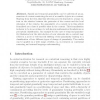Free Online Productivity Tools
i2Speak
i2Symbol
i2OCR
iTex2Img
iWeb2Print
iWeb2Shot
i2Type
iPdf2Split
iPdf2Merge
i2Bopomofo
i2Arabic
i2Style
i2Image
i2PDF
iLatex2Rtf
Sci2ools
CONTEXT
2005
Springer
2005
Springer
Granularity as a Parameter of Context
Abstract. Spatial and temporal granularity can be understood as parameters of context restricting the set of accessible objects in a context. Starting from the idea that this selection process depends to a large extent on the relation between the grain-size of the context and the local extension of the objects, the granularity of a context is in this article formalised as a class of possible sizes in the context. This formalisation is shown to be in accordance to well-known mathematical foundations on perceptual classification. An example for the case of temporal granular
| Added | 26 Jun 2010 |
| Updated | 26 Jun 2010 |
| Type | Conference |
| Year | 2005 |
| Where | CONTEXT |
| Authors | Hedda Rahel Schmidtke |
Comments (0)

